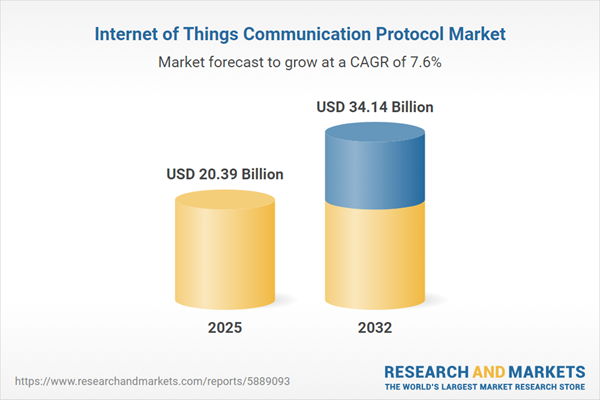Speak directly to the analyst to clarify any post sales queries you may have.
Enterprises worldwide are adapting their digital operations to leverage advanced IoT communication protocol solutions, fostering agile, secure networks across diverse business settings. This evolution enables senior decision-makers to efficiently manage increasingly complex digital infrastructures while supporting future growth.
Market Snapshot: IoT Communication Protocol Market Growth
The global IoT communication protocol market is experiencing steady expansion, with a valuation of USD 18.97 billion in 2024. Projections show this figure rising to USD 20.39 billion in 2025 and reaching USD 34.14 billion by 2032, representing a CAGR of 7.62%. As secure wireless connectivity becomes critical across industries, the need for robust IoT protocol solutions is fueled by regulatory evolution and rapid technological advancements. Enterprises increasingly prioritize network security and scalability, adopting comprehensive communication protocols that support operational efficiency, compliance, and transformation initiatives across international markets.
Scope & Segmentation: IoT Communication Protocol Market
This report provides actionable insights for executive teams assessing deployment, optimization, and risk management in IoT communication protocol strategies. Coverage extends across technologies, usage scenarios, regions, and key industry players, presenting a comprehensive view for informed decision-making.
- Short Range Wireless: Bluetooth Classic, Bluetooth Low Energy, Thread, Wi-Fi, Z-Wave, and Zigbee are suited to automation and manufacturing, ensuring low-latency and secure device interaction essential for responsive system performance.
- Cellular IoT: EC-GSM-IoT, LTE-M, and Narrowband IoT support high-capacity, persistent connectivity for sectors like smart cities, transportation, and distributed assets—enabling large-scale, flexible integration.
- Low Power Wide Area Network: LoRaWAN, NB-Fi, Sigfox, and Weightless provide efficient, long-range communication in industries such as logistics, agriculture, and energy where system monitoring and real-time tracking are crucial.
- Satellite IoT: Protocols from providers like Globalstar, Iridium, and Orbcom offer essential connectivity in remote or infrastructure-limited environments including maritime, mining, and wide-area energy deployments.
- Americas: Includes the U.S., Canada, and Latin America; companies face varying regulatory and infrastructure requirements, making localized compliance strategies integral to successful deployment.
- Europe, Middle East & Africa: Regions such as the UK, Germany, UAE, and South Africa present distinct challenges, with local regulations and unique operational factors influencing technology adoption and performance.
- Asia-Pacific: Markets like China, Japan, India, Australia, and Southeast Asia are advancing quickly, reflecting growing investment in network infrastructure and rising demand for scalable, adaptable protocol solutions.
- Key Companies: Leading vendors including Cisco Systems, Huawei Technologies, Ericsson, Nokia Solutions and Networks, Qualcomm, Intel, IBM, Sierra Wireless, Bosch Software Innovations, and Software AG are shaping industry innovation and strategic partnership ecosystems.
Key Takeaways for Senior Leaders
- Adopt a phased approach to IoT protocol integration, aligning new deployments with overarching organizational transformation efforts for reliable network performance.
- Tailor protocol choices to suit regional regulations and radio-frequency environments, streamlining compliance and minimizing complexity in global expansion efforts.
- Foster collaboration between protocol developers, technology providers, and other stakeholders to build strategic, flexible connectivity solutions that can evolve with enterprise needs.
- Prioritize protocol and device interoperability standards, ensuring smoother future upgrades and integration while controlling total cost of ownership.
- Embed cybersecurity best practices at every stage of rollout, fortifying networks against emerging threats as IoT adoption scales within enterprise environments.
Tariff Impact: Navigating U.S. Policy and Supply Chain Dynamics
Recent U.S. semiconductor tariffs necessitate a review of procurement strategies and protocol selection. By focusing on energy efficiency and strengthening supply chain resilience, enterprises can mitigate risks related to distribution delays and maintain service continuity amid shifting trade conditions. Adaptability in the face of regulatory changes is essential for risk management across regulated sectors and geographically dispersed operations.
Methodology & Data Sources
This analysis is based on extensive secondary research, including the review of international standards, patent filings, and verified industry documents. Expert interviews and scenario analysis further enhance the findings, offering a comprehensive perspective on IoT protocol adoption and security considerations.
Why This Report Matters
- Senior leaders gain targeted, actionable research for making informed choices on IoT communication protocol deployment, ensuring network agility and reliability.
- The report clarifies the varied regulatory and implementation challenges across global regions, expediting time-sensitive digital transformation initiatives.
- Facilitates strategic evaluation of partners and resource allocation, aligning technology investment with sustained operational resilience and competitive advantage.
Conclusion
Implementing modern IoT communication protocols enables organizations to build secure, adaptive networks that underpin enduring digital progress. The insights offered support leaders in addressing connectivity, compliance, and transformation challenges confidently and effectively.
Additional Product Information:
- Purchase of this report includes 1 year online access with quarterly updates.
- This report can be updated on request. Please contact our Customer Experience team using the Ask a Question widget on our website.
Table of Contents
3. Executive Summary
4. Market Overview
7. Cumulative Impact of Artificial Intelligence 2025
Companies Mentioned
The companies profiled in this Internet of Things Communication Protocol market report include:- Cisco Systems, Inc.
- Huawei Technologies Co., Ltd.
- Ericsson AB
- Nokia Solutions and Networks Oy
- Qualcomm Incorporated
- Intel Corporation
- International Business Machines Corporation
- Sierra Wireless, Inc.
- Bosch Software Innovations GmbH
- Software AG
Table Information
| Report Attribute | Details |
|---|---|
| No. of Pages | 189 |
| Published | November 2025 |
| Forecast Period | 2025 - 2032 |
| Estimated Market Value ( USD | $ 20.39 Billion |
| Forecasted Market Value ( USD | $ 34.14 Billion |
| Compound Annual Growth Rate | 7.6% |
| Regions Covered | Global |
| No. of Companies Mentioned | 11 |









